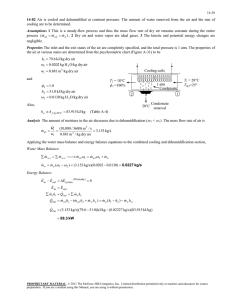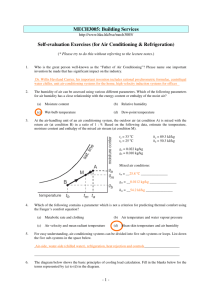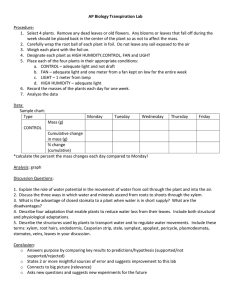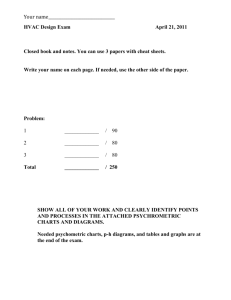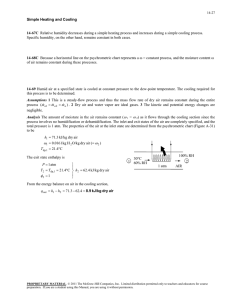C R ONTRACT EPORT
advertisement
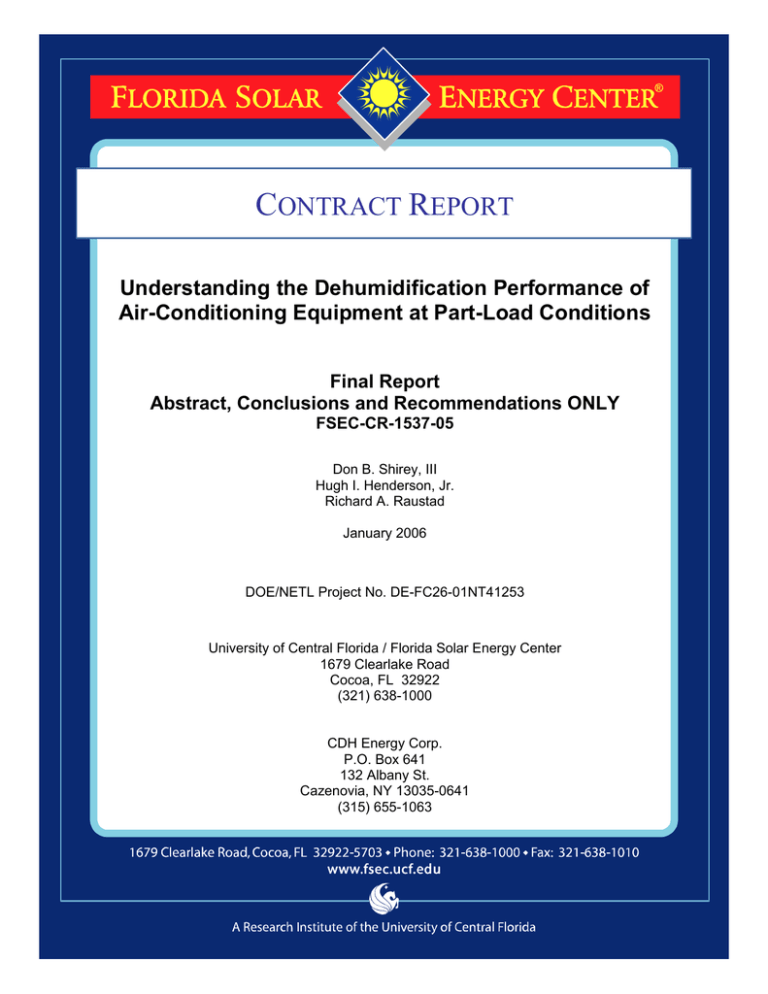
DISCLAIMER This report was prepared as an account of work sponsored by an agency of the United States Government. Neither the United States Government nor any agency thereof, nor any of their employees, makes any warranty, express or implied, or assumes any legal liability or responsibility for the accuracy, completeness, or usefulness of any information, apparatus, product, or process disclosed, or represents that its use would not infringe privately owned rights. Reference herein to any specific commercial product, process, or service by trade name, trademark, manufacturer, or otherwise does not Understanding the Dehumidification Performance of necessarily constitute or imply its endorsement, recommendation, or favoring by the United States Government or any agency thereof. views and opinions of authors Air-Conditioning Equipment at The Part-Load Conditions expressed herein do not necessarily state or reflect those of the United States Government or any agency thereof. CONTRACT REPORT Final Report Abstract, Conclusions and Recommendations ONLY FSEC-CR-1537-05 Don B. Shirey, III Hugh I. Henderson, Jr. Richard A. Raustad January 2006 DOE/NETL Project No. DE-FC26-01NT41253 University of Central Florida / Florida Solar Energy Center 1679 Clearlake Road Cocoa, FL 32922 (321) 638-1000 CDH Energy Corp. P.O. Box 641 132 Albany St. Cazenovia, NY 13035-0641 (315) 655-1063 i DISCLAIMER This report was prepared as an account of work sponsored by an agency of the United States Government. Neither the United States Government nor any agency thereof, nor any of their employees, makes any warranty, express or implied, or assumes any legal liability or responsibility for the accuracy, completeness, or usefulness of any information, apparatus, product, or process disclosed, or represents that its use would not infringe privately owned rights. Reference herein to any specific commercial product, process, or service by trade name, trademark, manufacturer, or otherwise does not necessarily constitute or imply its endorsement, recommendation, or favoring by the United States Government or any agency thereof. The views and opinions of authors expressed herein do not necessarily state or reflect those of the United States Government or any agency thereof. i Abstract Air conditioner cooling coils typically provide both sensible cooling and moisture removal. Data from a limited number of field studies (Khattar et al. 1985; Henderson and Rengarajan 1996; Henderson 1998) have demonstrated that the moisture removal capacity of a cooling coil degrades at part-load conditions – especially when the supply fan operates continuously while the cooling coil cycles on and off. Degradation occurs because moisture that condenses on the coil surfaces during the cooling cycle evaporates back into air stream when the coil is off. This degradation affects the ability of cooling equipment to maintain proper indoor humidity levels and may negatively impact indoor air quality. This report summarizes the results of a comprehensive project to better understand and quantify the moisture removal (dehumidification) performance of cooling coils at part-load conditions. A review of the open literature was initially conducted to learn from previous research on this topic. Detailed performance measurements were then collected for eight cooling coils in a controlled laboratory setting to understand the impact of coil geometry and operating conditions on transient moisture condensation and evaporation by the coils. Measurements of cooling coil dehumidification performance and space humidity levels were also collected at seven field test sites. Finally, an existing engineering model to predict dehumidification performance degradation for single-stage cooling equipment at part-load conditions (Henderson and Rengarajan 1996) was enhanced to include a broader range of fan control strategies and an improved theoretical basis for modeling off-cycle moisture evaporation from cooling coils. The improved model was validated with the laboratory measurements, and this report provides guidance for users regarding proper model inputs. The model is suitable for use in computerized calculation procedures such as hourly or sub-hourly building energy simulation programs (e.g., DOE’s EnergyPlus building energy simulation program, http://www.energyplus.gov ). ii 7 Conclusions and Recommendations 7.1 Conclusions The latent capacity of a cooling coil degrades at part-load conditions. This degradation is most significant when the supply air fan operates continuously with a single-stage cooling coil. However, some degradation also occurs with modulated and multi-stage cooling systems as well. Continuous supply air fan operation is used in nearly all commercial buildings to provide the outdoor air ventilation requirements prescribed by ANSI/ASHRAE Standard 62.1 (ASHRAE 2004a) and to provide air circulation for occupant comfort. Continuous fan operation is also becoming more prevalent for residential applications for a variety of reasons, including central air filtration (e.g., UVC lamps or high-efficiency air filters) and new recommendations for wholebuilding ventilation with outdoor air (ASHRAE 2004b). The impact of latent capacity degradation must be considered in these circumstances. The results from this research project confirm and quantify the impact equipment oversizing has on humidity control. Whether operating with continuous fan operation, as is common in commercial applications, or in the AUTO fan mode, as most residential systems do, dehumidification performance degrades at part-load conditions. Oversizing air-conditioning equipment increases the time spent at part load and results in higher space humidity levels. Carefully sizing equipment to match the cooling load requirements results in better humidity control and higher system efficiency since part-load losses are minimized. Modulated chilled water coils also experience latent degradation at part-load conditions. Field testing of a constant air volume chilled water coil in a Florida commercial building confirmed the expected drop in latent capacity as the water flow rate through the chilled water coil modulates to match the sensible cooling load requirements. In constant air volume applications where improved humidity control is important, designers should consider controlling cooling capacity by bypassing air around the coil. The air bypass method clearly provides better humidity control at part load compared to systems that modulate capacity by varying the chilled water flow rate. Variable air volume systems also provide good dehumidification when controlled to an appropriate discharge air temperature. AUTO fan control, where the supply air fan cycles on and off with the cooling coil, nearly always improves the dehumidification performance of a cooling system. However, continuous fan operation is often required as noted above. Strategies are available to minimize moisture evaporation during the coil off cycle and improve dehumidification performance. These strategies include turning off the fan for all or part of the coil off cycle, using lower supply airflow rates during the coil off cycle, and/or bypassing air around the coil during the off cycle. The improved latent degradation model developed as part of this project can be used to quantify the impacts of these strategies on dehumidification performance. The latent degradation model can also be incorporated into dynamic building energy simulation programs (e.g., DOE’s EnergyPlus program), providing a tool for evaluating the implications of equipment design and operating strategies on indoor humidity levels during part-load operation. 7-1 Multiple stages of cooling capacity can greatly mitigate the impact of latent degradation at part load. For example, field measurements of a 10-ton (35kW) rooftop packaged unit showed that having two stages of cooling capacity significantly reduced the impact of latent degradation even with continuous supply air fan operation. This two-stage cooling system had a single cooling coil with two independent refrigerant circuits and a single compressor for each circuit. The cooling coil was configured in the face-split arrangement, with the bottom half of the coil served by compressor 1 (1st stage cooling) and the top half of the coil served by compressor 2 (2nd stage of cooling). This combination of multiple cooling stages and coil circuiting yielded good part-load dehumidification performance. Smaller residential equipment can also benefit from multiple stages of cooling capacity. For these systems, the cooling coil is typically composed of a single refrigerant circuit. Therefore, the key to good part-load dehumidification performance for this type of system is to properly vary the supply air fan speed with cooling capacity to maintain cold coil temperatures at each stage of cooling. Air flow will likely need to be reduced in greater proportion than total cooling capacity to keep coil temperatures low at part load (e.g., 50% reduction in total cooling capacity may require a 55-60% reduction in airflow rate). Many equipment manufacturers use fan delay strategies to extract additional cooling from a coil at the end of a cooling cycle. These strategies are used in residential applications where AUTO fan control is the norm. While this strategy may (or may not) slightly improve the energy efficiency of a system, our findings demonstrate that it clearly degrades the latent removal capacity of a system. Fan delay strategies have a significant negative impact on dehumidification capacity and should be avoided in any application where high humidity is a concern. Equipment manufacturers almost always provide a means to disable this fan delay strategy (described in the installation documents). Residential equipment with variable-speed supply air fans are being offered by several equipment manufacturers. In addition to reduced fan energy consumption, these supply air fans give manufacturers the flexibility to vary fan speed to improve performance under various operating conditions. Several equipment manufacturers have implemented supply fan control schemes intended to limit latent capacity degradation or enhance steady-state dehumidification. These schemes include a combination of reduced air flow rate at the beginning of the cooling cycle, and sometimes also include a fan delay (i.e., continued fan operation for a brief period after the compressor turns off). Field measurements collected during this project for two such systems indicated little-to-no reduction in indoor humidity levels with these “enhanced dehumidification” control strategies compared to conventional AUTO fan control. Fan delay (overrun) is included as part of this control scheme by some manufacturers, and this aspect of the control should be eliminated since project results clearly indicate that this degrades dehumidification performance. Some manufacturers are also providing supply air fan controls where fan operation is stopped for a fixed interval right after the cooling coils ends, with fan operation restarted after the fixed interval. This type of fan delay is often called a “drain-down cycle” because of the misguided belief that water drains from the coil when the fan is off for a few minutes. Project results 7-2 indicate that reasonable fan drain-down periods of 2 to 5 minutes yield only modest improvement in part-load dehumidification performance compared to continuous fan operation. 7.2 Recommendations for Further Work The results from this project and previous research have led to a good understanding of the dehumidification (latent cooling) performance of single-stage DX cooling coils at part-load conditions. An existing engineering model to predict latent capacity degradation at part load was enhanced as part of this project to include a broader range of fan control strategies and an improved theoretical basis for modeling off-cycle moisture evaporation from the cooling coil. The improved model was validated with laboratory measurements, and this project has yielded better guidance for users regarding proper inputs for the model. The majority of laboratory and field tests to date regarding part-load dehumidification performance of cooling coils have focused on single-stage DX cooling equipment, which is typically used in residential and light commercial applications. As part of this project, testing was expanded to include one two-stage rooftop packaged unit (field site) and three chilled water coils (two field sites and one lab test coil). While this expansion has provided better insight into the part-load dehumidification performance of these commercial systems, further study is clearly warranted for these equipment types. Two-stage DX rooftop packaged units are used extensively in commercial and institutional applications, making this equipment a particularly high priority for future work. The improved latent degradation model developed as part of this project may be able to properly model part-load latent performance for 2-stage constant air volume DX equipment, but additional laboratory and field testing is needed to validate the model predictions and to provide users with guidance for model inputs specific to this type of equipment. Another recommendation is to implement the improved latent degradation model in various analysis tools, including DOE’s state-of-the-art EnergyPlus™ building energy simulation program. The original latent degradation model by Henderson and Rengarajan (1996) was implemented in EnergyPlus in 2003 by the Florida Solar Energy Center (FSEC). Therefore, the improved model developed as part of this project should be relatively easy to incorporate in EnergyPlus. In addition, the guidance developed during this project for selecting proper model inputs should be included as part of the EnergyPlus user documentation. FSEC is part of DOE’s EnergyPlus development team, and updating EnergyPlus with this latest latent degradation model will be proposed to the DOE Analysis Tools Technology Development Manager for consideration in FY2007. Once EnergyPlus has been updated with the improved latent degradation model, the next important step would be to use EnergyPlus to demonstrate the ramifications of fan controls on indoor humidity levels and energy consumption. A series of simulations should be completed to demonstrate both good and bad practices so building professionals and owners/operators better understand the impacts of different fan control strategies. In many cases building designers and owner/operators are unable to perform part-load analyses, or don’t realize the importance of doing so. Publications containing these simulation results will raise overall awareness of this critical aspect of system performance, and provide some general guidance on “do’s and don’ts” 7-3 regarding fan controls. With the benefit of this guidance, part-load analysis for a specific application can be more focused on viable solutions. Another important follow up to this project would be to partner with HVAC equipment manufacturers to develop equipment designs and control algorithms that mitigate the impacts of part-load latent degradation, and/or improve the overall dehumidification performance of systems for applications where it is required. A critical first step would be to conduct a thorough market evaluation. For example EnergyPlus, with the updated latent degradation model, could be used as part of an extensive simulation study to determine the impact of part-load latent degradation on indoor humidity levels and energy use for a variety of commercial and residential applications across a range of geographic locations. Prototypical buildings can be modeled with conventional HVAC systems as well as systems that use enhanced control techniques and/or other system improvements to increase dehumidification performance. The results of the market evaluation would clearly identify which HVAC markets have the greatest issue with high humidity control, and the extent to which commercially-available enhanced control techniques can improve indoor humidity control and occupant comfort. HVAC equipment designers will benefit by better understanding the limitations and benefits of technologies and control strategies already available in the marketplace, and the results will identify markets for equipment manufacturers where further humidity enhancements are required. Following the market evaluation, it is important to assist industry partners in evaluating and incorporating new enhanced dehumidification strategies in their products. This project identified several control strategies that are currently used to enhance dehumidification, and field test results showed that some strategies were more effective than others. One way to assist industry partners would be to work with them to systematically assess the efficacy of various control strategies using laboratory testing and computer simulations. Laboratory tests could be performed to determine the impact of various control scenarios on coil dehumidification performance, and the updated latent-degradation engineering model resulting from this project could be used to assess the impact of the control strategies on indoor humidity levels in various building applications. Depending on the laboratory test results, this may require further updates or enhancements to the latent-degradation engineering model. Any model improvements could be incorporated into EnergyPlus, and ultimately make their way into the wide array of mainstream energy analysis and load sizing software tools that will be used by hundreds of engineers and designers throughout the industry. 7-4
